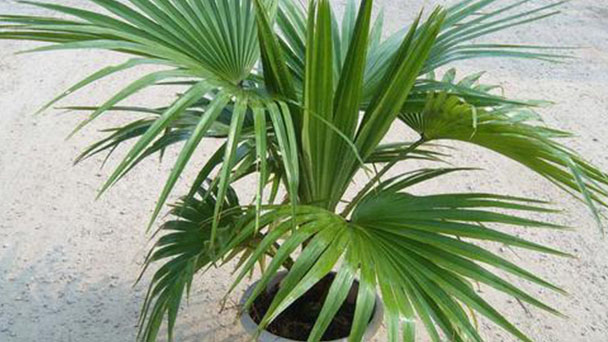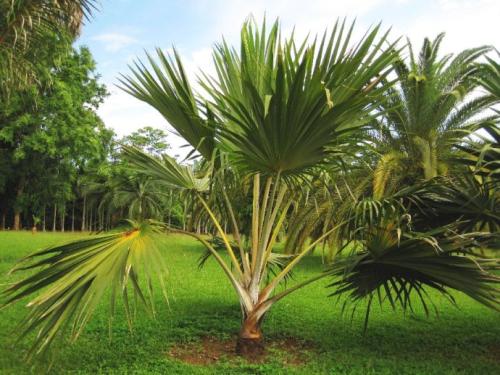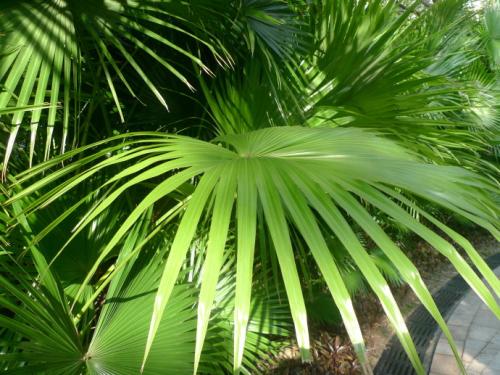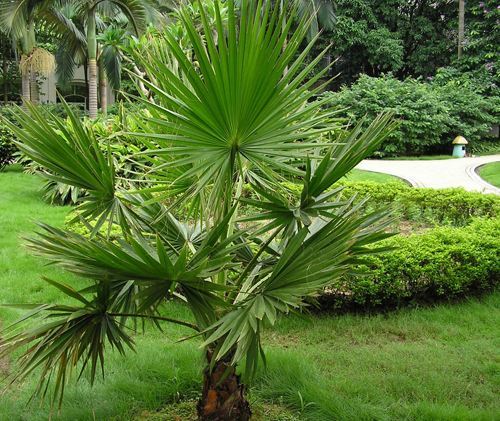Chinese Fan Palm (Fountain Palm) Profile
Written by Maggie
Nov 05 2021

Chinese fan palm (Latin name: Livistona chinensis (Jacq.) R. Br.), also called fountain palm, is a perennial evergreen tree of the genus Chinese fan palm in the palm family. It can reach 20 meters in height and is often enlarged at the base, with broad leaves and fan-shaped kidneys and oval olive fruits.
Chinese fan palm is not only a kind of garden ornamental plant and a good afforestation tree, but also an economic forest tree. Chinese fan palms can be prepared with its tender leaves; Old leaves make coir raincoat, leaf lobe rib veins can make toothpicks; The fruit and root are used as medicine.
Chinese fan palm picture
Chinese fan palm info
| Botanical Name | Livistona chinensis |
| Common Names | Chinese fan palm, fountain palm |
| Plant Type | Palm tree |
| Sun | Full sun to part shade |
| Hardiness Zones | 9 to 10 (USDA) |
| Flower color | Insignificant flowers |
| Native Area | East Asia; widely naturalized in many subtropical areas |
| Mature size | 30 to 40 feet tall; 12-foot spread |
Morphological characteristics of Chinese fan palm
The shape
Chinese fan palm is arborescent, 5-20 meters high, 20-30 cm in diameter, often enlarged at the base.
Leaf
Chinese fan palm leaves are broadly reniform fan-shaped, up to 1 m in diam., palmate-lobed to middle, lobes linear-lanceolate, base 4 -- 4.5 cm wide, apex long acuminate, 2 lobes filiform pendent lobes up to 50 cm long, green on both sides; Petiole is 1-2 m, with yellowish green (fresh) or light brown (dry) downcurving short spines on either side of the lower part.
Flowers
The inflorescence of Chinese fan palm is paniculate, stout, about 1 m long, with 6-7 spathe on the peduncle and about 6 branched inflorescences, up to 35 cm long, each with 1 spathe at the base of the inflorescence, with two or three branches, and the florets 10-20 cm long. Flowers are small, bisexual, ca. 2 mm long; Calyx lobes into 3 broadly triangular subacute lobes near base, lobes with broad dry membranous margins; Corolla ca. is 2 times as long as calyx, lobed to middle into 3 semi-ovate acute lobes; chinese fan palm has 6 stamens, base connate into a cupped and adnate to corolla base, filaments slightly thick, broadly triangular, mutate into short subulate pointed, anthers broadly elliptic; The ovary is deeply carved above the carpel, style mutated into a drill.
Fruit
The fruit of Chinese fan palm is elliptic (such as olive shape), 1.8-2.2 cm long, 1-1.2 cm in diameter, dark brown. Seeds are elliptic, 1.5 cm long and 0.9 cm in diameter, embryos slightly lower midway about opposite the seed ridge.
Flowering and flowering of Chinese fan palm in spring.
The appearance of Chinese fan palm is similar to that of a palm, which is difficult to distinguish. The differences are as follows:
Body size
The palm is only about ten metres high. However, it is common for Chinese fan palm to grow up to 20 meters high, and Chinese fan palm has larger leaves, thicker stems and faster growth.
Shape differences
There are only a lot of continuous distributions of small blunt thorns on palm petiole, while Chinese fan palm petiole is separated from each other by sharp barbs. The leaves of the palm are not only small, but also deep, and the ends of the leaves are not pendent and straight under normal circumstances (without external force). Chinese fan palm leaves are larger, leaf cracks are shallow (so we commonly use Chinese fan palm leaves are generally processed from the palm leaves, palm leaves are not only less and small, leaf cracks deep, not suitable for fans), leaf crack tip natural sag. Moreover, the fiber on the stem of Chinese fan palm is less than that of palm, and it is easy to fall off and expose the trunk. Palm is thick and dense, not easy to fall off (in some places for the production of palm bark or for the beauty of the artificial peel, palm bark is China's traditional export material)., is the adaptation to the cold environment.
Ecological habits of Chinese fan palm
Chinese fan palm likes warm and humid climates. They are not drought-tolerant and can withstand short-term waterlogging. They are afraid of the hot sun in the north.It grows well in fertile, wet and organic soil.
How to grow and care for Chinese fan palm
Light
Chinese fan palm does excellent with loads of daylight however it can tolerate section shade, as well. Indoors, the tree does nice with a lot of vibrant oblique light, however out of direct sunlight.
Soil
Outdoors, develop this tree in any regular medium-moisture soil. Indoors, the Chinese fan palm can develop in any well-drained potting mix.
Water
Chinese fan palms are pretty drought tolerant and many are grown in dry areas like Texas and New Mexico. Though the palm does want some water, its watering can be scaled returned as soon as the developing season ends. But indoor flora will without difficulty soak up two or three mild waterings per week, supplied the roots do not soak in water.
Temperature and humidity
The Chinese fan palm is one of the few frost-resistant palm trees, and it can tolerate temperatures as low as 20 stages Fahrenheit. It does properly in each humid and pretty dry air condition.
Fertilizer
Chinese fan palm will develop quicker if often fertilized, which additionally will stop it from creating a dietary deficiency. An 8-2-12 palm fertilizer is best, and fertilization is even extra necessary if it’s grown outside. Indoor flowers need to be fed as soon as a month. (Find more fall plants here.)
Pruning
It's a correct thinking to cast off the palm’s lifeless leaves at the backside of the crown about as soon as a year.
Potting and repotting
Like most palms, a Chinese fan palm developing in a container doesn’t want to be repotted often, due to the fact developing in a pot notably slows its growth. Planting the palm in a large adequate pot for its root machine ought to put off the want to repot, except the soil is depleted or it outgrows its pot. If so, make certain now not to harm the fragile roots in the course of the transition to a large pot.
These are as a substitute giant indoor plants, developing as an awful lot as 12 ft tall, so they are quality appropriate for massive rooms with excessive ceilings.

The propagation mode of Chinese fan palm
Chinese fan palm is propagated by sowing and usually begins to bear fruit after 15 months. Results by the end of the year. Although the seed is mature, it takes 4 to 5 months to germinate after sowing. If the winter seed, it is appropriate to bury sand, to be soaked in late spring after accelerating germination sowing. It is best to leave the seeds on the trees for winter. When the temperature rises to about 30°C in May, the seeds of Chinese fan palm will germinate on the trees. At this time, it is the best to sow immediately after seed collection, and the germination rate can reach 100%.
Seeding should be shallow, with nests 2-3 cm deep and about 1 square foot apart. Sow 4 seeds in each brood. After watering, cover them with the powder of household garbage screened for the emergence of seeds. Seedlings unearthed need to dig soil, so that the seedlings are unearthed neatly.
Disease & pest control of Chinese fan palm
Chinese fan palm has strong resistance to diseases and insect pests. The common diseases are leaf blight, anthracnose, brown spot, leaf spot, and blight.
The main pests of Chinese fan palm are Chlorophyllum SPP.
Distribution area of Chinese fan palm
Chinese fan palm is a Chinese specialty, its origin is in the south of Qinling Mountains and Huaihe River.
Chinese fan palm is distributed in South China (Guangdong, Guangxi, Dian, Qiong, Taiwan), Ryukyu and Ogasawara islands.
Chinese fan palm uses
Medical uses
Seeds: Anti-cancer. For esophageal cancer, chorionic epithelial cancer, malignant mole, leukemia.
Root: Pain relief. Made into injections to treat all kinds of pain.
The garden use of Chinese fan palm
Chinese fan palm is a large number of potted plants that are often used in the hall or reception room display. Place it at the gate and other venues under a semi-overcast tree, and avoid direct sunlight at noon. The leaf is often used as a cattail fan.
Life
Chinese fan palm can be prepared with its tender leaves; The old leaves make coir raincoat, leaf lobe rib vein can make toothpicks.
The botanical garden
Chinese fan palm is evergreen with an umbrella-shaped crown and big leaves like fans. It is an important tree species in tropical and subtropical areas. Often planted scenery, summer shade shade, a tropical scenery.

Read Next:
Top 30 Fall Flowers to Plant - Beautiful Autumn Flowers
30 Fall Plants for a Beautiful Fall Garden
Latest Updated
- Benefits of Bugleweed - 7 Science-backed Health Benefits
- Bugleweed Dangers & Side Effects - Is It Poisonous?
- How to Plant Evergreen Trees - What You Should Know
- When to Plant Evergreens - Grow Guide for Evergreen Trees
- 12 Wonderful Evergreen Shrubs for Your Garden
- 12 Popular Evergreen Plants with Pictures for Beginners
- When And How To Prune A Lilac Bush Like a Pro
- How to Grow & Care for Lilac Vine (Hardenbergia Violacea)
- Japanese Lilac Tree (Syringa Reticulata) Care & Propagation Guide
- Shumard Oak Pros and Cons - What to Know
Popular Articles
- Winter maintenance of Antirrhinum Majus
- How to Grow Terminalia Mantaly Tree
- How to Grow and Care for Crossostephium Chinense
- How to grow Antirrhinum Majus in spring
- Peristeria Elata (Dove Orchid) Profile: Info & Care Guide
- Underwatered Snake Plant (Sansevieria Trifasciata) - Signs And How To Fix
- How to Care for Brazilian Jasmine Plant (Mandevilla Sanderi)
- How to Grow & Care for Graptopetalum Purple Delight in Summer
- Rosa Chinensis (China Rose): Plant Growing & Care Tips
- How to Care for Baby Sun Rose (Aptenia Cordifolia)
